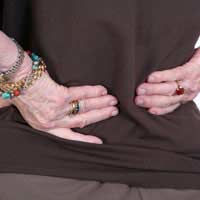Back Pain and Hernia

A hernia happens when part of the body is pushed through a hole (usually a weakened area of muscle) in another part of the body. Hernias can be spontaneous (they just happen), congenital (something that people are born with), or traumatic (the result of an accident).
There are a number of different types of hernia:
- inguinal hernia
- lumbar hernia
- hiatal hernia
- femoral hernia
- umbilical hernia
- incisional hernia
- diaphragmatic hernia
What Is An Inguinal Hernia?
This happens when part of the small intestine (the lower part of the bowel) bulges though a weak part of the muscles in the groin (the lower part of the abdomen). It is more common in men than in women. The bulge (the herniated part of the intestine) can usually be pushed back through into the body, unless it becomes strangulated.Back Pain And Inguinal Hernia
The symptoms of an inguinal hernia include pain in the area of the hernia, but can also include pain that radiates round to the back or down the leg, because the inflammation of the hernia can press on the nerves. This is known as ‘referred’ pain. The pain of an inguinal hernia is usually worsened by lifting, straining, coughing, bending or exercise, and usually goes away with rest. Other symptoms of hernia include nausea and a ‘dragging’ feeling.Treating Inguinal Hernia
Inguinal hernias can be treated temporarily with a truss, which uses pads to press the hernia back into the abdomen, and this can be used while patients wait for surgery, or if they can’t have an operation because of other conditions. However, surgery is the only way to repair an inguinal hernia permanently.Traditional surgery for an inguinal hernia involves making a cut over the weakened part of muscle, putting a piece of mesh in place, and then sewing up the incision, which will hold the mesh in place. The mesh triggers tissue growth, which completes the repair. The operation often uses a local anaesthetic. As well as improving recovery time and allowing patients to go home the same day, using a local anaesthetic means that and surgeons can check whether the repair is secure by asking patients to cough or strain.
Surgeons can also repair inguinal hernias using keyhole (laparoscopic) surgery, also under a local anaesthetic. This also uses a piece of mesh, but because the cut is smaller, recovery is faster and there is less pain.
After the operation, once the cut is healed, strengthening abdominal muscles and maintaining a healthy weight can reduce the risk of hernias re-occurring – and these will both help avoid general back pain as well.
Lumbar Hernia
A lumbar hernia is a very rare form of hernia, where a weakening in the back muscles allows internal organs, such as the colon, to protrude through a gap. This can cause back pain. There have only been around 300 cases of lumbar hernia reported in medical journals in the past 300 years. Lumbar hernias can be difficult to diagnose, but are repaired in the same way as inguinal hernias.Lumbar hernias are not the same as lumbar disc hernias, which are also known as slipped discs.
Business Energy With a Difference
If you are looking for business energy or need advanced solutions like remote energy monitoring, new supplies, downgrading or upgrading capacity, have a no obligation chat with Purely Energy.
To find our more get in touch here. or call 0161 521 3400.







